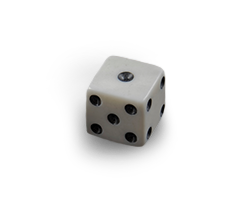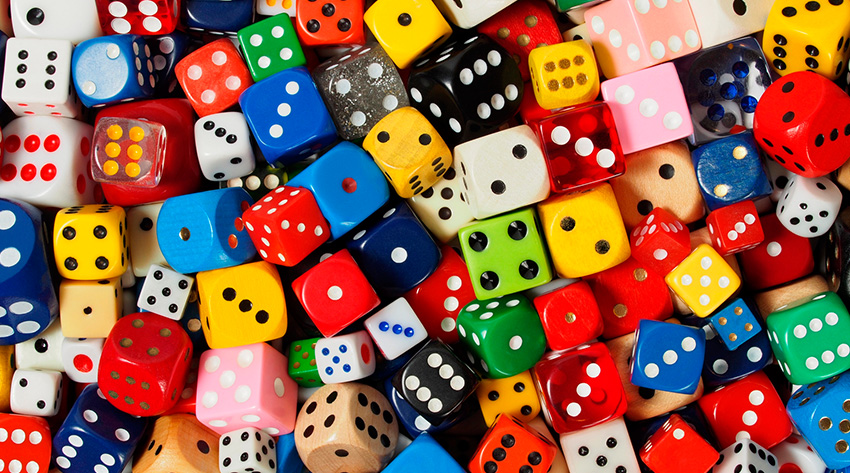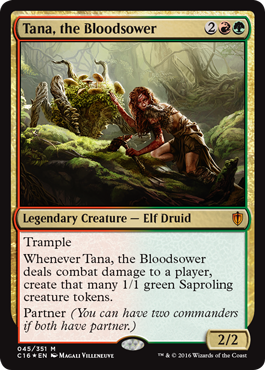An Introduction to Commander
"I'll cast Cathars' Crusade."
"What does that do?"
"Whenever a creature enters the battlefield for me, I put a +1/+1 counter on all my creatures."

"Just that creature?"
"No, all of them."

"Each time?"
"Every time."
"Uh, yeah. No. I'm going to counter that with Insidious Will."
"Well, that's probably fair. Okay. Go ahead."
"Untap, upkeep, draw, land, go."
"At the end of your turn I'll double my tokens with Rhys the Redeemed. That's four more green-white Elf Warrior tokens, two more Servo tokens, and three more white Soldier tokens."
"Okay. Wait. I'll cycle Decree of Pain."
"You're a pain."
"...Yeah, that's pretty fair right now, too."
Welcome to Commander.
What is Magic Commander?
There are a few ways to describe Commander. Technically, it's just a Constructed format with some particular rules that set it apart from things like Standard or Modern.
- You use a 100-card deck, including a legendary creature that begins the game in your command zone rather than your library.
- Your deck can only include cards that use the mana symbols of the mana cost and rules text of your chosen legendary creature—the "color identity" of your commander.
- Other than basic lands, each card in your deck must have a different name. (That is, no duplicate cards.)
- You start the game with 40 life.
- You can cast your legendary creature from the command zone as though it were in your hand, and if that creature were to leave the battlefield to go anywhere, you can instead choose to put it back in the command zone. It costs an additional two generic mana to cast again each time it returns in this way.
- If you take 21 combat damage from any one opponent's commander over the course of the game, you lose.
While there are some more corners to that, such as the illustrative list of banned cards, games of Commander follow your typical multiplayer Magic from there.
But there's another way to describe Commander, and that philosophy is where the official rules site linked above begins:
Commander is designed to promote social games of Magic.
It is played in a variety of ways, depending on player preference, but a common vision ties together the global community to help them enjoy a different kind of Magic. That vision is predicated on a social contract: an unwritten agreement that goes beyond these rules to include a degree of interactivity between players. Players should aim to interact both during the game and before it begins, discussing with other players what they expect/want from the game.
House rules or "fair play" exceptions are always encouraged if they result in more fun for the local community.
Where competitive formats seek to balance the playing field for all styles and strategies, we want to encourage a style of game that is more open and directed toward all players having a good time regardless of who wins. This is summarized as "Create games that you'd love to remember, not the ones others would like to forget."
Or, in so many words, Commander is a way to focus on having fun with friends playing Magic rather than simply defeating opponents. It's not the victory but the experience that matters.
What do I need to know about Commander?
Commander has advantages and disadvantages like any Magic format. The downsides are obvious:
- You need a lot of cards. For Commander, piling up unique cards can be difficult—though Commander (2016 Edition) decks come ready to help you with this.
- You need multiple players at once. For Commander, a singular opponent is difficult to balance against the goal of creating a mutually pleasant game. Multiple players really do change how games feel and play out.
- You need to commit more time to a game. Because you have multiple opponents and start with more life, Commander games take more time. If you've played Conspiracy: Take the Crown, you have a sense of how long things can go.
The advantages, though, are more than impressive:
- You get to explore cards and themes unlike anywhere else in Magic. When each player's goal is to have fun with others, you can go deep with strange cards (Dubious Challenge), new themes (energy counters), or anything else that comes up—like trying out two commanders at the same time.


- You can plan on casting expensive cards. When you draft a deck or build something for Standard, how much mana things cost is important. While you still need to consider it in Commander, the opportunity to cast big, splashy, over-the-top spells is one you get to embrace.
- Your commander is always there for you. If you really like a certain legendary creature, you can use it to your heart's content! Whether it's an old goodie (Captain Sisay) or something powerful and new (Rashmi, Eternities Crafter), you can be sure your favored legend is available for you anytime.
- Randomness is a feature, not a bug. When you pile up almost a hundred unique cards, you can expect a different game each time. You can always work against this—and you probably should in at least some way—but the excitement of drawing different cards and getting more play out of the same deck in back-to-back games is amazing.
- Restrictions breed creativity. The Mark Rosewater adage applies when you need so many different cards within a narrow set of colors. Finding "gems" you'd overlook in other scenarios and digging through every card you can find lets you explore Magic freely.
How do I get started?
The easiest way to jump into Commander, particularly if you've yet to dabble in the format, is to pick up a Commander 2016 deck when they release. Off the shelf, it's going to solve all of the things you need to consider below and give you a great selection of cards that can be used in a Commander deck of your own making.
To begin building your own deck, start by finding a legendary creature in colors you like. You don't need to worry if it's "good" or "powerful" the first time around; you just want to get a feel for how things work and use the colors of spells you already enjoy playing with.
Piling up the cards you want to play with it come next. Focus on the fun things you'd like to do and not on finding the "best" paths and cards to break opponents down. It's okay to try a card you're not sure about or feels weak. Exploration and self-discovery is important.
You'll want to split your attention to multiple kinds of cards as you choose them:
- Threats, like powerful creatures or expensive spells that can upend the game. You want to have strong things to do throughout the game. Sometimes this is your commander, like Depala, Pilot Exemplar or Rashmi, Eternities Crafter, but it's also Verdurous Gearhulk or a timely Stunt Double to copy your opponent's biggest monster.
- Answers, like removal or counterspells that can help you stay in the game. You don't want to have too many, but holding onto ways to break up an opponent's plan is helpful. Creature-based removal is nice—see Keepsake Gorgon and Ruinous Gremlin—but Unlicensed Disintegration and Fumigate are just as useful here as in Standard.
- Card draw, through artifacts, lands, or a mechanic like cycling. The monarch mechanic from Conspiracy: Take the Crown encouraged attacking, but it also helps spread around ways to draw an extra card or three. Keeping your deck moving with some ways to smooth out what you have later in the game ensures the game focuses on fun rather than waiting—hoping—for something to do.
- Mana smoothing (like mana rocks) and ways to search up lands or abilities (like landcycling). Ensuring you can cast the spells you'd like is important, so whether it's Cultivator's Caravan or Absorb Vis you should consider some ways at lower mana costs to set up more expensive choices.
- Mana fixing, particularly through simple lands. Temple Garden and Inspiring Vantage are virtually required for other Constructed formats, but Commander turns that on its head. If you're playing just one or two colors, the appropriate basic lands and a few ways to help find them is more than enough. At three or four colors, it isn't a stretch to fix things with lands you don't need for Standard or Modern, such as Evolving Wilds, Exotic Orchard, Tranquil Expanse, and Jungle Hollow.
Across all the types of cards you'll want to include, there is a "meta-class" of cards that can guide you: Commander staples. These are often older (and oft-reprinted) cards that can go into a wide variety of Commander decks. Artifacts and lands are abundant here, but every color has its own share of cards that can slot in nearly any deck you imagine.
These are the kinds of cards you see over and over when looking up Commander decklists online. They're also cards that fellow Commander players will recommend and rattle off the top of their heads. Some examples include:
- Solemn Simulacrum, which finds you a land regardless of the number of colors you're playing then draws you another card on its way out. Filigree Familiar is similarly helpful for smoothing out a deck with generically helpful effects.
- Swiftfoot Boots and Sword of Light and Shadow are two of the many powerful Equipment cards to consider. Hexproof and haste make commanders powerful, especially if they have activated abilities. Sword of Light and Shadow grants protection from colors packed with removal and lets you get a creature back every turn you knock an opponent with it—excellent for colors that typically don't have that kind of ability.
- Color-breaking effects shine bright. Sword of Light and Shadow is an example of this, but colors have them too. Gate to Phyrexia, Chaos Warp, Tithe, and other ways colors get to do things they ordinarily can't make it easier to build decks exclusively using that color. When you don't need to consider dipping into green for artifact destruction or black to get rid of a creature forever, it goes a long way.
What happens next?
Play! Find friends, visit your local game store, and get started seeing what Commander is all about. Like all formats that tap into most printed Magic cards and rely on a local community for support, you have to begin experiencing things yourself to understand it.
More important than playing is having fun. Swap in cool cards you want to try next. Track down the new rare you just want to play somewhere. Ask friends to give you a chance to play the new cards you just drew.
The philosophy of Commander is about creating unforgettable memories. You'll make plenty if you keep everyone's fun in mind.

